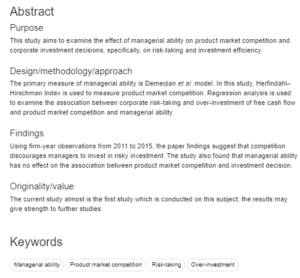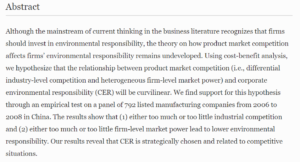Writing an Abstract
- An Abstract:
An abstract is the summary of more extensive work and usually written in 150-300 words depending on the type of publication (thesis or manuscript). Although it placed at the beginning of the report, after the title page, it is considered as the last section of the thesis writing. This is because it summarises all parts of the paper or thesis or manuscript briefly.
The academic literature uses the abstract to communicate complex researches. It is the stand-alone entity instead of the full paper. The abstract is used to select the study that is proposed for paper presentation, poster presentation, workshop and also helpful in funding the research project.
- The primary function of writing an abstract is to describe, not evaluate or define the research.
- The abstract for the research should start with a brief but precise statement or issue, followed by a description of the research method and design.
- Purpose of the abstract:
- It helps potential readers to determine the pertinent of your project for their research.
- To address your key findings with the people who don’t have time to read the whole paper.
- When submitting manuscripts or articles to journals
- Applying for research grants
- Writing a research proposal
- Writing a proposal for a book chapter
- When completing the PhD dissertation or MPhil or M.S, or M.A thesis
- Writing a proposal for a conference paper
III. The Abstract should include,
The abstract allows you to expand upon each significant aspect of the research and helps readers decide whether they want to read the rest of the. Therefore, enough key information must be included while making the abstract useful to someone who may want to examine your work.
- It includes the research question and objective of the study.
- Methods used in the research.
- Abstract states the key results and argument on the research.
- Conclusion of the research.
The following presents the format of your abstract. Although it varies depending on the discipline in which you are working, it follows general guidelines.
- Background of the Problem:
An abstract should emphasize the importance of the research, and why would a reader be interested in more extensive work?
- Objectives
An abstract of scientific work should emphases the problem does this work attempt to solve. An abstract should state the specific models or approach used in the study. And also describe the types of evidence used in the research to solve the issue.
- Methodology:
The methodology section of your Abstract is your chance to summarize the primary hypothesis of your study. Excessive detail is unnecessary; therefore, you should briefly state the specific models or approaches used in the more extensive research.
- Results:
An abstract should state the specific findings of the study by including detailed data that indicates the results of the research.
- Implications
An abstract should include implications that emphases the changes that need to be implemented as a result of the findings and how does it add to the body of knowledge on the topic
- Different types of Abstract Published within the same discipline
 Figure 1. An example of an Abstract Published in Emerald Journals. Discipline: Management
Figure 1. An example of an Abstract Published in Emerald Journals. Discipline: Management
Source: Adapted from Salehi, M., Daemi, A. and Akbari, F. (2020), “The effect of managerial ability on product market competition and corporate investment decisions: Evidence from Iran”, Journal of Islamic Accounting and Business Research, Vol. 11 No. 1, pp. 49-69. https://doi.org/10.1108/JIABR-10-2016-0113
 Figure 2. An example of an Abstract Published in Springer Journals. Discipline: Management
Figure 2. An example of an Abstract Published in Springer Journals. Discipline: Management
Source: Meng, X.H., Zeng, S.X., Xie, X.M. et al. The impact of product market competition on corporate environmental responsibility. Asia Pac J Manag 33, 267–291 (2016).
- How not to write an abstract?
- Do not refer extensively to unrelated works.
- Do not add information that does not contain the original work.
- Do not define terms.
- Abstract keywords:
- It may include the thesis of the research work done.
- The background information places an essential role in the large body of literature.
- May include the same chronological structure as the original work.




